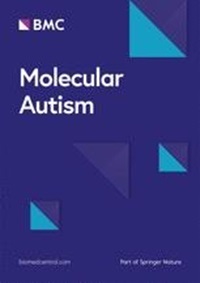母亲的自闭症特质与儿童自闭症特质之间的关联是否受母亲孕前体重指数的调节?
IF 6.3
1区 医学
Q1 GENETICS & HEREDITY
引用次数: 0
摘要
以往的研究表明,母亲的自闭症特质与孩子的自闭症特质之间存在正相关。我们还测试了这种关联是否在孕前体重指数(BMI)较高的母亲中更为明显。这项研究包含两个队列,其中 4,659 名参与者来自 R 世代,179 名参与者来自剑桥超声波兄弟姐妹和父母项目(CUSP)队列。在这两个队列中,母亲的自闭症特征通过自闭症谱系商数简表进行评估,母亲怀孕前的身高和体重信息则通过问卷调查获得。儿童自闭症特质的评估在R世代(中龄=13.5岁)中采用社会反应性量表简表,在CUSP队列(中龄=1.6岁)中采用幼儿自闭症定量核对表(Q-CHAT)。在幼儿期(CUSP队列;β调整后=0.20,p<0.01)、幼儿期(R一代;β调整后=0.19,p<0.01)和青春期早期(R一代;β调整后=0.16,p<0.01),母亲较高的自闭症特质与较高的自闭症特质相关。此外,母亲孕前体重指数越高,儿童自闭症特质越高,但仅在 R 代(βadjusted = 0.03,p < 0.01)。在 R 代和 CUSP 中,母亲孕前体重指数对母亲和儿童自闭症特质之间的关联没有明显的调节作用。此外,与体重健康的母亲相比,体重不足的母亲和体重超重的母亲的子女自闭症特质得分明显更高。我们证实了母亲与幼儿期、幼儿期和青春期早期儿童自闭症特征之间的关联。潜在的相互影响的神经生物学过程仍有待证实。本文章由计算机程序翻译,如有差异,请以英文原文为准。
Is the association between mothers’ autistic traits and childhood autistic traits moderated by maternal pre-pregnancy body mass index?
Previous studies showed that there is a positive association between mothers’ and children’s autistic traits. We also tested if this association is more pronounced in mothers with a higher pre-pregnancy body mass index (BMI). The study was embedded in two cohorts with information available for 4,659 participants from the Generation R and for 179 participants from the Cambridge Ultrasound Siblings and Parents Project (CUSP) cohort. In both cohorts, maternal autistic traits were assessed using the short form of the Autism Spectrum Quotient, and information about maternal height and weight before pregnancy was obtained by questionnaire. Child autistic traits were assessed with the short form of Social Responsiveness Scale in Generation R (M = 13.5 years) and with the Quantitative Checklist for Autism in Toddlers (Q-CHAT) in the CUSP cohort (M = 1.6 years). Higher maternal autistic traits were associated with higher autistic traits in toddlerhood (CUSP cohort; βadjusted = 0.20, p < 0.01), in early childhood (Generation R; βadjusted = 0.19, p < 0.01), and in early adolescence (Generation R; βadjusted = 0.16, p < 0.01). Furthermore, a higher maternal pre-pregnancy BMI was associated with higher child autistic traits, but only in Generation R (βadjusted = 0.03, p < 0.01). There was no significant moderating effect of maternal pre-pregnancy BMI on the association between autistic traits of mothers and children, neither in Generation R nor in CUSP. In addition, child autistic traits scores were significantly higher in mothers who were underweight and in mothers who were overweight compared to mothers with a healthy weight. We confirm the association between maternal and child autistic traits in toddlerhood, early childhood, and early adolescence. Potential interacting neurobiological processes remain to be confirmed.
求助全文
通过发布文献求助,成功后即可免费获取论文全文。
去求助
来源期刊

Molecular Autism
GENETICS & HEREDITY-NEUROSCIENCES
CiteScore
12.10
自引率
1.60%
发文量
44
审稿时长
17 weeks
期刊介绍:
Molecular Autism is a peer-reviewed, open access journal that publishes high-quality basic, translational and clinical research that has relevance to the etiology, pathobiology, or treatment of autism and related neurodevelopmental conditions. Research that includes integration across levels is encouraged. Molecular Autism publishes empirical studies, reviews, and brief communications.
 求助内容:
求助内容: 应助结果提醒方式:
应助结果提醒方式:


